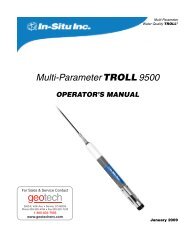TEST INSTRUCTIONS - Geotech Environmental Equipment
TEST INSTRUCTIONS - Geotech Environmental Equipment
TEST INSTRUCTIONS - Geotech Environmental Equipment
You also want an ePaper? Increase the reach of your titles
YUMPU automatically turns print PDFs into web optimized ePapers that Google loves.
SULFATE–HIGH RANGE<br />
BARIUM CHLORIDE METHOD CODE 3665-SC<br />
QUANTITY CONTENTS CODE<br />
10 g *Sulfate Reagent *V-6277-D<br />
1 Spoon, 0.1 g, plastic 0699<br />
*WARNING: Reagents marked with an * are considered hazardous substances. To<br />
view or print a Material Safety Data Sheet (MSDS) for these reagents see MSDS CD<br />
or our web site. To obtain a printed copy, contact us by e-mail, phone or fax.<br />
The most common mineral forms of sulfur are iron sulfide, lead sulfide, zinc<br />
sulfide and as calcium sulfate and magnesium sulfate. In most fresh waters the<br />
sulfate ion is the second or third most abundant anion, being exceeded only by<br />
bicarbonate and, in some cases, silicate. Sulfur, in the form of sulfate, is<br />
considered an important nutrient element. Mineral springs are rich in sulfate<br />
and feed appreciable quantities of this compound to the watershed. Acid mine<br />
water drainage is a form of pollution which may contribute extremely large<br />
amounts of sulfate content to natural waters. Other sources of sulfate include<br />
waste material from pulp mills, steel mills, food processing operations and<br />
municipal wastes. Many bacteria obtain sulfur from sulfate for the synthesis of<br />
amino acids. In lakes and streams low in oxygen, this process of sulfate<br />
reduction causes the production of hydrogen sulfide, with its characteristic<br />
offensive odor. Calcium sulfate and magnesium sulfate contribute significantly<br />
to the hardness of water. Under natural conditions, the quantities ordinarily to<br />
be expected in lakes are between 3 and 30 parts per million.<br />
APPLICATION: Drinking and surface waters, domestic and industrial wastes.<br />
RANGE: 0–100 ppm Sulfate<br />
METHOD: Sulfate ion is precipitated in an acid medium with barium<br />
chloride to form a barium sulfate suspension in proportion to<br />
SAMPLE<br />
HANDLING &<br />
PRESERVATION:<br />
the amount of sulfate present.<br />
Sulfate samples may be preserved by refrigeration at 4°C up<br />
to 7 days in glass or plastic containers without any change in<br />
concentration.<br />
INTERFERENCE: Suspended matter and color interference may be removed by<br />
a filtration step. Silica in excess of 500 mg/L will interfere.<br />
Check for stray light interference (see page 17).<br />
Smart2 <strong>TEST</strong> PROCEDURES 2.04 Sulfate–HR 1/2

















